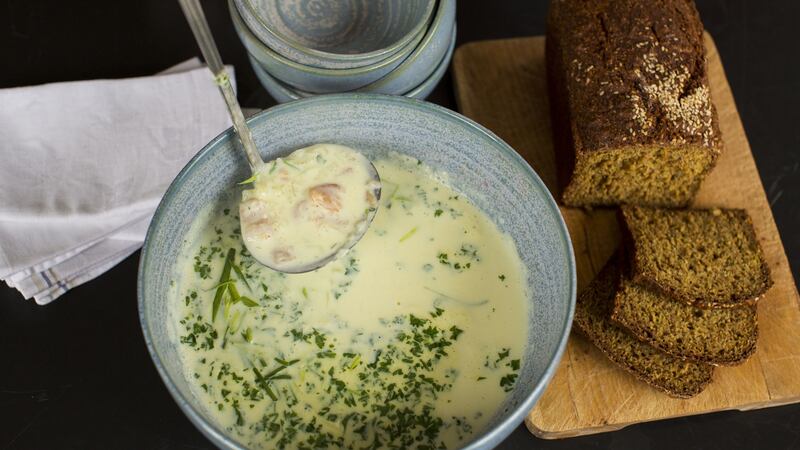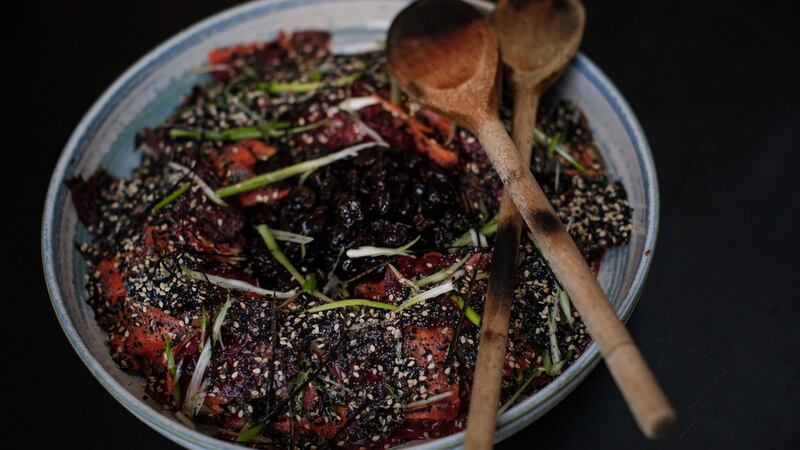Seaweed, seaweed everywhere. So why are we not eating more of it? It’s always in season, comes to us in dry form, both ground down and whole, with many varieties to choose.
One of my biggest food revelations was discovering the health benefits of eating seaweed. My first introduction was about 10 years ago when I ended up at an evening talk in Ballymaloe given by Dr Prannie Rhatigan. She served up seaweed in every dish – from smoothies to the scones below.
At once I started to introduce it into my family diet and then on the restaurant menu. We have it every day disguised in granola, in a sauce with turmeric and ginger to go with fish or vegetables, salads, mixed with salt and pepper and sprinkled on roasted potatoes, stuffed into roast lamb with garlic and even in chocolate ice-cream.
In recent years, I have had the great gift to be able to work alongside Sally McKenna who wrote the amazing book Extreme Greens. During our classes together and through reading her book, we as a family have learned that "seaweed is probiotic, has more anti-oxidants than raspberries and twice as much vitamin C as orange juice, 10 times more calcium as cow's milk and 50 times as much iron as spinach".
Also and probably most important of all, when we are trying to include it in our diets and especially that of our children we must remember that it contains glutamates (the magic) which our bodies love. So banish any preconceptions of slimy seaweed on the shore and start adding it slowly into your diet from breakfast to lunch and dinner as a new year’s health resolution and I promise that you won’t regret it.
Dulse and cheese scones
When we made these for the photoshoot they disappeared very quickly! I can eat them with just about anything, never mind on their own, but they do go amazingly well with chowder.
Ingredients
(Makes 10 to 12 regular scones or 20 to 22 small)
40g (1 1/2 oz) dulse, toasted and crumbled
Olive oil
1 medium onion, very finely chopped
500g (1 lb) plain flour
1 tsp baking powder
2 tsps mustard powder or regular plain mustard
85g (2 1/2 oz) butter, cold
1 egg, beaten
225ml (8 fl oz) milk
85g (3 oz) grated strong sheep or goat’s cheese or a strong cheddar
Method
1. Preheat the oven 210° C/Gas Mark 6.
2. Put the dried dulse in a dry pan over a moderate heat. Turn often until it becomes brittle and easily crumbles between your finger and thumb. Remove from heat, and crumble into flakes when cool enough to handle. The toasting also adds to the flavour.
3. Heat the oil in a pan, add onions and fry gently until softened. Add the crumbled dulse towards the end along with the mustard and mix well. Set aside to cool.
4. While the onions are softening, put the flour and baking powder into a mixing bowl. Grate the butter into the flour and finish rubbing in with your fingertips until the mixture resembles fine breadcrumbs. Add in the cheese.
5. Beat the egg and add the milk, and add it to the flour mixture Mix gently to combine together with the cooled onion and dulse mixture.
6. Turn the dough on to a floured surface and flatten.
7. Using a cutter, stamp out scones and place on a floured baking tray.
8. Bake in oven for 15 to 20 minutes until golden. Remove and cool slightly on wire rack.
* Note: For a lighter, tender scone, handle the dough as little as possible. There’s no need to knead.
Seafood chowder
There is nothing like good chowder but over the years we have endured lots of bad imitations. Chowder should never have flour added – the only thickener being the potatoes, then bay leaf and milk and after that, you can make it your own as they have done in the different states of America after the Scots introduced it.
Adding the carrageen will also thicken it. Drop the bacon if you like, add in an extra bay leaf instead or some fresh thyme. If you are lucky enough to be able to get Gloun farm milk to use, you will not need any cream as it’s very creamy so just use it instead of the cream. I do find buying a carton of cream a waste unless I have use for the leftovers (you can always freeze any that is left).

Ingredients
(Serves 4)
25g butter
100g sliced green streaky bacon, cut into bite size pieces
1 medium onion, finely chopped
Salt and pepper
400ml milk
100ml cream
A medium piece of carrageen, with any grit removed
300g peeled potatoes, cut into uneven bite size pieces
1 bay leaf, very finely shredded
500ml fish stock
500g proper smoked haddock (or just some nice fresh fish such as haddock) chopped
2 tbsp chopped parsley
Method
1. Melt the butter in the pan, add the bacon and fry over a medium heat until golden. Add the onion, some seasoning and cook gently until softened.
2. Add the milk, cream, potatoes, bay leaf, carrageen and the fish stock. Bring to the boil, then simmer for about 5 to 7 minutes or until the potatoes are tender and the carrageen will start to dissolve.
3. Add the smoked haddock with the chopped parsley and check the seasoning and serve.
4. If you would like to make the chowder in advance, once the potatoes are softened remove fromthe heat and chill until needed. Then reheat and add the fish and parsley.
Sea vegetable salad with pickled sour cherries
I have been making many different versions of this salad for years. I nearly always have it in the fridge as it’s an instant boost and keeps very well.
For an evening dinner in the restaurant I make it without the cherries and serve it with pan-fried fish and a seaweed butter. In my school lunchbox days, I would send it with the girls and they would beg me to cut the seaweed fine so others would not notice they were eating it!
I often replace dried cranberries for cherries as they are easier to find and less harsh on the pocket. The mixture of vegetables can be altered to suit what is available; I often use regular onion or leek in place of spring onions.

Ingredients
About 50g dried seaweed of your choice, a mix is nice.
1/2 cup dried sour cherries, soaked for 10 minutes in boiling water – just enough to cover
1/2 cup cider vinegar
1 tbsp sugar
Dressing:
1/2 cup white miso
1/2 cup honey or maple syrup
1/2 cup mirin
1/4 cup sesame oil
Lemon juice to taste
1/2inch ginger or to taste.
Vegetables:
2 beetroots, sliced thinly
3 medium carrots, sliced thinly
6 radishes, sliced thinly
4 spring onions, sliced thinly
2 tbsp sesame seeds
2 tbsp onion seeds
2 tbsp poppy seeds
½ sheet dry nori, cut into thin strips (optional)
Method
1. Soak the seaweed until soft and pliable (about 30 minutes), and give it a good squeeze and chop into bite-size pieces.
2. Bring the cider vinegar and the sugar slowly to the boil, add the cherries and the soaking water and let simmer for a couple of minutes, reducing the liquid a little. Allow to cool.
3. In the meantime, make the dressing by placing all the ingredients in a liquidiser and blending really well to bring out the ginger. Mix all your prepared vegetables and seaweed well together and pour the dressing, tossing everything as you go.
4. Next, take a large plate and pile the cooled sour cherries in the middle. Surround them with the seaweed and vegetable salad. Sprinkle the top with the seeds and the cut nori sheets.











